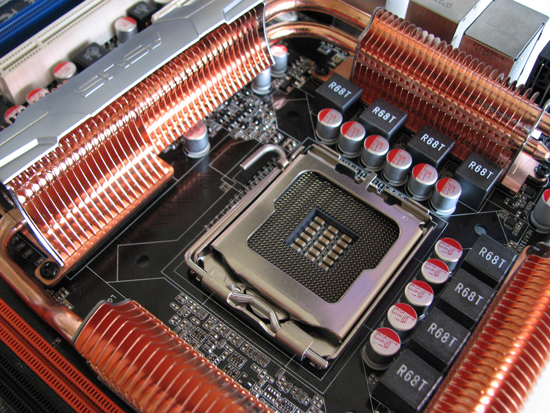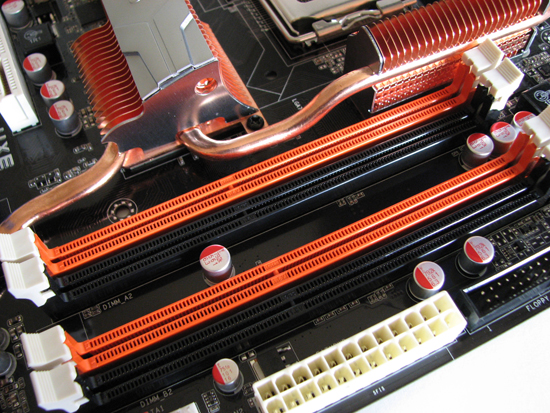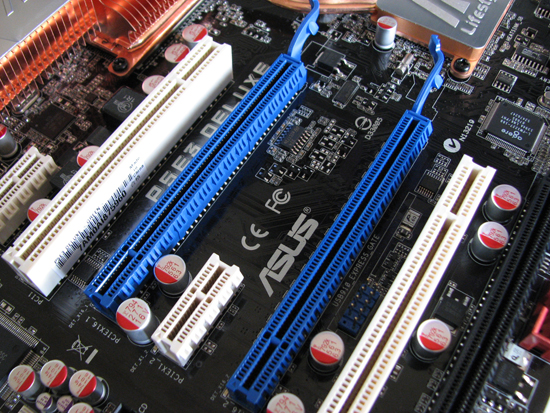ASUS P5E3 Deluxe Overclocking: DDR3 Takes Front Stage
by Kris Boughton on November 20, 2007 4:00 AM EST- Posted in
- CPUs
Board Layout and Features
ASUS decided to surround the LGA775 socket on all four sides with a generous portion of copper heatpipe-pierced heatsinks, in effect thermally adjoining the memory control hub (MCH) and both sets of power MOSFET banks. The portion of the cooler located between the CPU socket and memory DIMMs is "floating" above the board with a thin layer of electrically insulating material isolating it from the components below. As is usually the case, the stock mounting solution does not provide enough clamping pressure, resulting in increased thermal resistance that usually leads to higher component temperatures than would normally be experienced. We noticed this same problem on the abit IP35-Pro, although the ASUS design did provide better overall cooling.
The P5E3 Deluxe makes excellent use of an 8-phase power delivery system, a must for any board engineered to provide the high current required when pushing a quad-core processors well beyond stock speeds. Although the MOSFETs are completely capable of operating without issue over an exceptionally large temperature range (often able to survive temperatures reaching 120C or greater) it is the Northbridge (MCH) that we really worry about. Our testing has shown the X38 chipset to be particularly sensitive to sustained load temperatures in excess of about 50-55C.
The solution to correcting the lackluster mounting pressure was almost effortless (making us wonder why ASUS didn't make the extra effort and save us the trouble). We simply removed any hardware holding the heatpipe assembly to the board, cleaned all thermal surfaces with rubbing alcohol (making sure we allowed ample time for the board to completely dry), and then remounted the unit with a fresh coating of our favorite thermal paste. This time we used small machine screws and threaded nuts in place of the plastic pushpins. This allowed us to control the loading pressure, ensuring a secure bond between the copper and the heat sources. Looking at the picture above, please note the black replacement screws used to hold everything together. In the end, the effort we invested in improving our board's cooling efficiency resulted in more than an 8C drop in measured MCH load temperatures.
As we can see, ASUS has done a wonderful job of physically locating the DIMMs as close as possible to the MCH in an effort to minimize trace lengths and maximize overclocking potential. When combined with new design features on DDR3 modules, like fully terminated data and address signal lines and 2-phase power from the motherboard, these small changes can result in rather massive increases in memory operating frequencies with low voltages.
The X38 MCH provides official support for up to 8GB of low-voltage DDR3, meaning even the most memory intensive application running atop Windows Vista 64-bit should be happy. The primary 24-pin power connector is located on the bottom edge of the board with the supplementary 8-pin EPS12V power connector being located at the top of the board near the backplane.
Intel's ICH9R, although rated at no more than about 6W when operating, is connected to the stock board cooling solution using a single heatpipe - no doubt, we discovered the Southbridge heatsink is hotter for this very reason than it otherwise would be. The board provides six SATA ports, more than enough for most overclockers. Unfortunately, ASUS decided not to include an LED POST code reader somewhere making it difficult to determine exactly what the board is doing during the POST period.
The small blue header to the bottom of the board is used for clearing the BIOS should the need arise. We were pleasantly surprised as to how gracefully the board recovered from a failed setting - one quick full-power cycle and the board defaulted to safe settings allowing us to easily enter the BIOS and correct our mistake.
One of the features separating the X38 chipset from the mainstream segment P35 MCH is the addition of PCI-E 2.0 specification compatibility. The blue slots connect direct to the MCH and each provides the full 16 lanes of bandwidth - though truthfully, we can't see the additional bandwidth really helping much as PCI-E throughput often isn't the limiting factor, especially with PCI-E 2.0 already doubling the bandwidth for 1.x. The third x16 slot (black) can operate at either x1 or x4 speeds. Two PCI slots and one additional PCI-E x1 slot round out the board's expansion capabilities.
 |
ASUS decided to surround the LGA775 socket on all four sides with a generous portion of copper heatpipe-pierced heatsinks, in effect thermally adjoining the memory control hub (MCH) and both sets of power MOSFET banks. The portion of the cooler located between the CPU socket and memory DIMMs is "floating" above the board with a thin layer of electrically insulating material isolating it from the components below. As is usually the case, the stock mounting solution does not provide enough clamping pressure, resulting in increased thermal resistance that usually leads to higher component temperatures than would normally be experienced. We noticed this same problem on the abit IP35-Pro, although the ASUS design did provide better overall cooling.
The P5E3 Deluxe makes excellent use of an 8-phase power delivery system, a must for any board engineered to provide the high current required when pushing a quad-core processors well beyond stock speeds. Although the MOSFETs are completely capable of operating without issue over an exceptionally large temperature range (often able to survive temperatures reaching 120C or greater) it is the Northbridge (MCH) that we really worry about. Our testing has shown the X38 chipset to be particularly sensitive to sustained load temperatures in excess of about 50-55C.
 |
The solution to correcting the lackluster mounting pressure was almost effortless (making us wonder why ASUS didn't make the extra effort and save us the trouble). We simply removed any hardware holding the heatpipe assembly to the board, cleaned all thermal surfaces with rubbing alcohol (making sure we allowed ample time for the board to completely dry), and then remounted the unit with a fresh coating of our favorite thermal paste. This time we used small machine screws and threaded nuts in place of the plastic pushpins. This allowed us to control the loading pressure, ensuring a secure bond between the copper and the heat sources. Looking at the picture above, please note the black replacement screws used to hold everything together. In the end, the effort we invested in improving our board's cooling efficiency resulted in more than an 8C drop in measured MCH load temperatures.
 |
As we can see, ASUS has done a wonderful job of physically locating the DIMMs as close as possible to the MCH in an effort to minimize trace lengths and maximize overclocking potential. When combined with new design features on DDR3 modules, like fully terminated data and address signal lines and 2-phase power from the motherboard, these small changes can result in rather massive increases in memory operating frequencies with low voltages.
The X38 MCH provides official support for up to 8GB of low-voltage DDR3, meaning even the most memory intensive application running atop Windows Vista 64-bit should be happy. The primary 24-pin power connector is located on the bottom edge of the board with the supplementary 8-pin EPS12V power connector being located at the top of the board near the backplane.
 |
Intel's ICH9R, although rated at no more than about 6W when operating, is connected to the stock board cooling solution using a single heatpipe - no doubt, we discovered the Southbridge heatsink is hotter for this very reason than it otherwise would be. The board provides six SATA ports, more than enough for most overclockers. Unfortunately, ASUS decided not to include an LED POST code reader somewhere making it difficult to determine exactly what the board is doing during the POST period.
The small blue header to the bottom of the board is used for clearing the BIOS should the need arise. We were pleasantly surprised as to how gracefully the board recovered from a failed setting - one quick full-power cycle and the board defaulted to safe settings allowing us to easily enter the BIOS and correct our mistake.
 |
One of the features separating the X38 chipset from the mainstream segment P35 MCH is the addition of PCI-E 2.0 specification compatibility. The blue slots connect direct to the MCH and each provides the full 16 lanes of bandwidth - though truthfully, we can't see the additional bandwidth really helping much as PCI-E throughput often isn't the limiting factor, especially with PCI-E 2.0 already doubling the bandwidth for 1.x. The third x16 slot (black) can operate at either x1 or x4 speeds. Two PCI slots and one additional PCI-E x1 slot round out the board's expansion capabilities.










25 Comments
View All Comments
retrospooty - Friday, November 23, 2007 - link
I should have added that beyond the current Intel roadmap, they are looking at Rambus XDR for future CPU's. DDR and its minor generational bumps arent going to cut it for long. DDR4 and DDR5 arent much better, higher speeds and higher latencies all the way = very minor performance increases.I really wouldnt advise anyone, even the enthusiests to get DDR3 now, in 1 more year Nehalem will be out with 3 channel DDR and it will likely be faster, or lower latency and cheaper than current DDR3 is, and anyone who fancies themselves and "enthusiest" will be upgrading again at that point, because 3 channel DDR3 on top of Nehalems internal memory controller WILL give a notable performance increase.
jkostans - Tuesday, November 20, 2007 - link
Spending an extra $50-100 on a GPU is still way more effective than spending the $200-300 more for DDR3. The only games that struggle with framerate on a modern mid-high end system are mostly GPU and somewhat CPU dependent. You get about the least bang for your buck with memory, but at the bleeding edge of performance I guess money is not a barrier.TA152H - Tuesday, November 20, 2007 - link
Another way to look at it is, would you rather have 1 GB of DDR3 or 2 GB of DDR2? They cost roughly the same.I'd rather have the 1 GB, since I can add more memory later. If you end up with DDR2, your system is forever degraded by inferior memory. You can't add it later unless you get a new motherboard. Besides, faster memory makes everything run faster, more memory only makes things run faster if you have to page (pretty much, I know Microsoft steals memory for caching, but that's a mixed bag anyway). Also, more memory wants more power.
I can already hear the argument from people saying that you can get 1 GB of DDR2 as well, and still realize a cost saving. It's a valid point, but at 1 GB the cost difference isn't that great, and I think the performance, and future upgradeability still make DDR3 attractive for some people.
LoneWolf15 - Tuesday, November 20, 2007 - link
Another way to look at it is, would you rather have 4GB of high-performance DDR2 for $150 (or cheaper, my 4GB of Crucial Ballistix cost me $140 this summer and is cheaper yet now), or 2GB of DDR3 for $200?
The industry must really love folks like you, who buy into the marketing hype. DDR2 is far from inferior, or Intel wouldn't have been using it all this time, and saying your system will be "forever degraded" is ridiculous tripe.
DDR3 has more bandwidth, but isn't necessarily "faster" as it is higher latency. That $150 DDR2 I mentioned has a CAS latency of 4; the $200 2GB DDR3 has a CAS latency of 7. DDR3 will only be attractive once it gains market share, lowering its price. What with enough P35 boards and some X38 boards still supporting DDR2, there is no reason to switch.
TA152H - Tuesday, November 20, 2007 - link
DDR3 is faster, if you can't accept that much, you aren't worth arguing with. DDR2 is inferior, but it's cheaper.DDR2 was not inferior until DDR3 came out. Inferior is a relative term, there has to be something better. Is English not your first language?
natebsi - Tuesday, November 20, 2007 - link
Sheesh. Personal attack much?TA152H - Tuesday, November 20, 2007 - link
Actually, you don't think his rant was a personal attack? If you don't agree with some people, you are just listening to marketing hype, or don't understand this or that. Instead of realizing there are reasons for both DDR2 (cost and compatibility) and DDR3 (everything else), you get people who accuse you of not understanding anything, and just being part of some company's marketing machine. It's so uneducated and insulting, it warrants something of the same kind back.Anyone that thinks DDR3 is completely useless, even now, is an idiot. This type of person is not worth arguing with. They are both useful, right now, and the arguments should really be about the gray areas where they begin to overlap. I might think DDR3's area is a little bigger than most, but at least I recognize that there are many people that are better off with DDR2. By the same token, I expect people to have at least basic intelligence and recognize there are areas where DDR3 makes more sense, even now. Pure performance always has a place, especially when it costs only $500, or less, more.
aeternitas - Sunday, December 9, 2007 - link
Grats on being the article clown.yyrkoon - Thursday, November 22, 2007 - link
I think the point if entirely lost on you.First, you can for instance get the same overclocks from DDR2 memory(at least from what I've seen here, because even my Promos 800 sticks can hit 1:1 475Mhz FSB which is 10Mhz faster than what I saw in the benches here).
Secondly, a system with 4GB of DDR2 vs 1-2GB of DDR3 *will* be more responsive. You can argue about it all you want, until you're blue in the face, and the only thing you will prove is that you have no actual hands on experience. Yes, this is even on a system with a 32BIT OS.
Thirdly, remember all the discussion a while back about AMD systems not performing any better than the Intel C2D systems despite having faster memory capabilities?
Lastly, even the writer of this article said the differences between the DDR2, and DDR3 system was barely a whisper . . .
But, you're right, anyone claiming that DDR3 RIGHT NOW is useless is an idiot, because they obviously can not see the eManhood effect capabilities here in saying that they paid X amount more for DDR3 vs DDR2. Anyone who has bragged about their $3000 usd set of car rims being much better than the stock rims that came with the car can surely see this point.
Griswold - Tuesday, November 20, 2007 - link
Oh yea I bet DDR3 makes perfect sense in your basement "lab" where you run your benchmarks all day long. Instead of yapping like a chihuaha with a superiority complex, you could instead just provide some realworld applications that make DDR3 not look like a waste of money right here, right now with todays hardware.Future proofing my ass, get a clue.